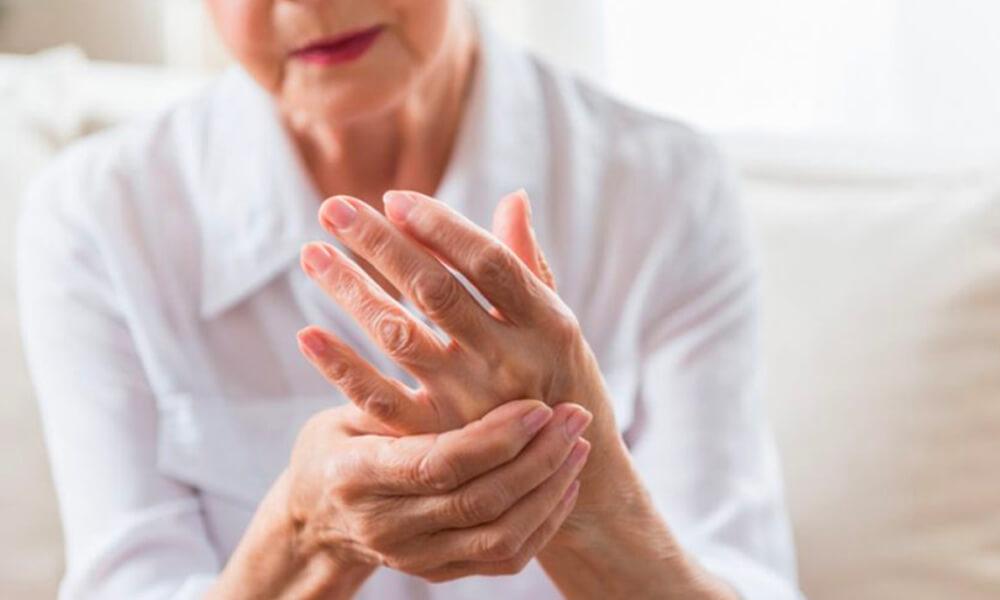
How are wrists and hands affected by arthritis?
Any joint in your fingers, thumbs, knuckles and wrists can be affected by psoriatic arthritis (PsA). In fact, these are some of the joints most commonly affected by joint pain, swelling and stiffness.
Dactylitis, often referred to as ‘sausage fingers’, is also very common in people with PsA, affecting around 40% of people. Dactylitis can affect fingers or toes and cause the whole digit to become swollen, making it painful and hard to bend.
People with PsA can also find that their nails are affected. Pitting of the nails and a condition called ‘onycholysis’ where the nail lifts away from the nail bed. These conditions are related to psoriasis and are often referred to as ‘nail psoriasis’.
Read Signs and symptoms of psoriatic arthritis for more information on dactylitis or nail psoriasis.
People with hand arthritis often find their grip weakens and it becomes harder to do fine movements, such as turning a key or tying shoelaces.
Find out about aids and equipment that can make everyday tasks easier. Learn ways to protect your hands and manage your symptoms.
How can I protect (rest) my sore hands?
The first thing to do is to become more aware of how you are using your sore joints. For example, try watching how you make a hot drink. What is happening to your wrist and fingers as you turn on the tap or lift a heavy kettle? Does it cause pain? Try to think of another way of doing this activity which will reduce those aches and strains. You might try picking up the kettle with two hands. Or use a tap turner to make it easier to grip the tap. These are examples of ‘joint protection’. It doesn’t mean you should stop using your joints. It just means that you should use them differently to reduce the amount of stress going through your joints. Read Protecting your joints for more information.
Here are some ways to protect the joints in your hands:
- Take notice of pain – it can serve as a warning that your joints are being overworked. Rather than giving up an activity altogether, try taking regular rests during the activity and learning ways to manage pain. You will usually find you can still do the things you enjoy without discomfort.
- Use larger, stronger joints – for example, carry your shopping bags over your shoulder rather than in your hands.
- Spread the load over several joints – try carrying things with two hands.
- Reduce the effort you have to put in – there is a wide range of labour-saving tools and equipment available. Buy pre-cut vegetables and meat to make cooking easier.
- Avoid gripping things tightly – find out about gadgets that can make gripping and holding objects easier.
- See an occupational therapist to learn more ways to make daily tasks easier and take pressure off your joints.
- Visit an Independent Living Centre. These centres have a wide range of tools and equipment on display. You can get advice, including where to purchase equipment, in person or over the phone.
- Occupational therapists are also available at the centres to provide advice about equipment. Although you can drop in at any time, it is preferred that you call the telephone enquiry service beforehand.
Are splints useful?
Splints may be helpful in some cases. They are often used to support the joint at the base of the thumb and for hands affected by PsA. Splints are usually worn only when the joint is painful or to protect the joint during certain activities. Splints should not stop you from moving or using your hands as this can cause the muscles to weaken. An occupational therapist can advise whether hand splints will be useful for you.
Should I exercise my hands?
Don’t be afraid to use your hands. Regular exercise is important in reducing stiffness and keeping your joints and muscles working. Try to make sure you move any affected joints in your fingers, thumbs, knuckles and wrists as far as is comfortable several times a day. You could also see an occupational therapist or physiotherapist for specific hand exercises.
What else can I do?
There are other treatments that may help you deal with pain and stiffness:
- Medicines: Many different types of medicines can help the symptoms of hand arthritis. Your doctor or pharmacist can help you understand which medicines are right for you and how best to use them.
- Heat and cold: Applying heat, such as a hot pack (microwaveable wheat pack), heating pad or hot water bottle to stiff, painful joints may help relieve these symptoms. If your joints are hot and swollen you may find it useful to apply an ice pack. Try applying heat or cold to the painful area for 15 minutes. Always have a layer (such as a tea towel) between your skin and the heat or ice pack. You can repeat this whenever you need to throughout the day. Make sure the temperature of the skin returns to normal in between applying heat or ice packs to prevent damage to the tissues.
- Creams: Applying creams or ointments containing anti-inflammatory medicines, capsaicin (an ingredient in cayenne and chilli peppers) or Arnica gel (a herbal medicine) may help control pain. Talk to your doctor or pharmacist about these types of creams.
- Low level laser therapy: There is some scientific proof that low level laser therapy (by a physiotherapist) can help reduce pain and swelling. See your physiotherapist for more information.
- Fish oils: Fish oils may be helpful for people with inflammatory forms of arthritis like PsA. Always let your doctor know if you are taking fish oils or any other natural medicines.
- Herbal therapies: Creams containing Arnica gel may help control pain. There is no conclusive proof that other herbal medicines are effective in treating arthritis of the hands.
CONTACT YOUR LOCAL ARTHRITIS OFFICE FOR MORE INFORMATION AND SUPPORT SERVICES.










